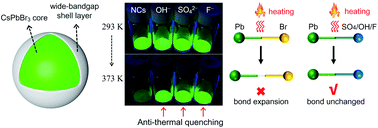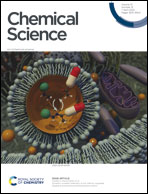Suppressing thermal quenching of lead halide perovskite nanocrystals by constructing a wide-bandgap surface layer for achieving thermally stable white light-emitting diodes†
Abstract
Lead halide perovskite nanocrystals as promising ultrapure emitters are outstanding candidates for next-generation light-emitting diodes (LEDs) and display applications, but the thermal quenching behavior of light emission has severely hampered their real-world applications. Here, we report an anion passivation strategy to suppress the emission thermal quenching behavior of CsPbBr3 perovskite nanocrystals. By treating with specific anions (such as SO42−, OH−, and F− ions), the corresponding wide-bandgap passivation layers, PbSO4, Pb(OH)2, and PbF2, were obtained. They not only repair the surface defects of CsPbBr3 nanocrystals but also stabilize the phase structure of the inner CsPbBr3 core by constructing a core–shell like structure. The photoluminescence thermal resistance experiments show that the treated sample could preserve 79% of its original emission intensity up to 373 K, far superior to that (17%) of pristine CsPbBr3. Based on the thermally stable CsPbBr3 nanocrystals, we achieved temperature-stable white LED devices with a stable electroluminescence spectrum, color gamut and color coordinates in thermal stress tests (up to 373 K).



 Please wait while we load your content...
Please wait while we load your content...